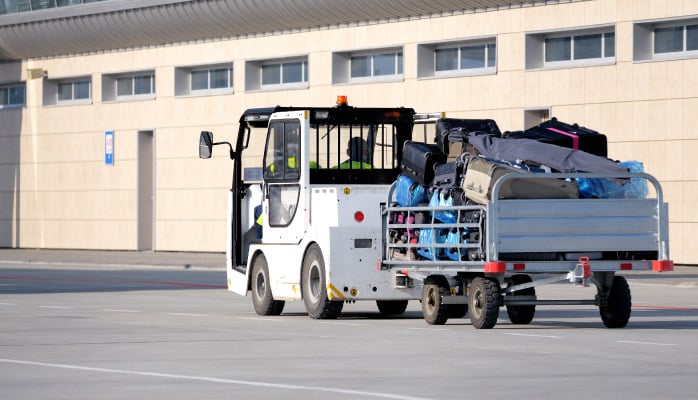The Goal of Good Safety Newsletters

The first and foremost goal of an aviation safety newsletter is safety promotion for an organization's aviation safety management system (SMS). Which, put more simply, means creating an interest and awareness in anything safety.
More broadly, safety promotion is a method of shifting focus towards aviation safety to encourage and train employees to identify hazards and report safety issues.
Too often safety newsletters confuse their purpose and focus on trying to squeeze “education” out of every single word of the newsletter.
This is a mistake.
Related Aviation Safety Promotion Articles
- 4 Pillars | What Is Safety Promotion Component (the "Overlooked" Pillar)
- Safety Chart: Stay on Top of Aviation Safety Promotion
- Why Safety Promotion Requires More Focus in Aviation SMS
What that usually ends up looking like is:
- Awkward and impersonal writing
- Boring overview of goals and progress
- Both of which amount to low reader numbers
So when we talk about the goal of a newsletter as a safety promotion, keep in mind that safety newsletters should be fun. They can be fun because of
- the tone of writing,
- funny content,
- interesting stories or
- interesting points about analyzed safety data.
But whether the focus of a particular newsletter is-
- Announcing
- Informing
- Instructing
-make sure that the content grabs people’s attention.
Qualities of Well Crafted Safety Newsletters

First, keep in mind two things:
- Writing is hard and takes time
- The newsletter doesn’t have to be a masterpiece
It simply needs to be engaging and have an upbeat tempo. Simpler said than done. A couple of good practices for creating quality safety newsletters are:
1 – Keep newsletters short
Keeping safety newsletters short and to the point makes your life easier because it allows the safety newsletter to focus on just a couple of main points. Thus, when crafting the content, you can spend your time focusing on quality rather than quantity.
Moreover, you will only have one shot to grab a reader’s attention – once he/she puts down the newsletter, they will likely never touch it again. When newsletters are only 1-2 pages long, people are more likely to open and read the entirety of newsletters than longer ones.
When newsletters are longer than 2 pages, an organization is usually wasting its time.
Related Aviation Safety Promotion Articles
- How to Promote Your Aviation SMS Safety Policy
- 10 Best Ways to Promote Safety in Your Aviation SMS [With Free Checklist]
- Aviation SMS Surveys - an Often Neglected Safety Promotion Tool
2 – More than just text
Whenever you can, use things like graphs, images, infographics, etc. They are more interesting and significantly more economical than text.
Moreover, they will break up the newsletter to give it a nice visual flow.
3 – Consistent and regular publications
This is tied in with point number one, but publish your short safety newsletters on a regular basis. For example, an organization that publishes a 2-page newsletter 3 times per month will see much higher and more thorough engagement than a 6-page monthly newsletter.
In both cases, the same content, and same length, except the weekly report comes in more manageable bites. Successful publications are fairly regular, such as 2-4 times per month depending on the size of the organization.
4 – Write with a purpose
The quality of the writing can make or break a newsletter. Especially if a newsletter incorporates images, graphs, etc. (as it should), each sentence should pack a punch. Again, it doesn’t need to be high literature, just simply that good writing is written with a purpose. Each sentence is thoughtful.
The difference between passive or “mindless” typing and thoughtful writing is evident in the final product, and considering that, ideally, the word count on a given newsletter will be fairly short, writing thoughtfully shouldn’t require much extra time.
5 – Address topics that are directly relevant to your organization

In general, people are most interested in things that are directly relevant to them. A newsletter should try and focus most of its content on the aviation SMS, and the individuals surrounding the program:
- Management
- Employees
- Vendors
- Contractors
However, make sure that topics are not “office politics.” A newsletter needs to maintain its integrity. Things like rewarding certain individuals for an outstanding idea or behavior can do wonders for engagement with a newsletter.
People like seeing their name in print, even if it is just in a weekly newsletter.
6 – Use templates
A safety newsletter templates allow consistency in visual style and flow of information, which in turn establishes a higher production value.
It also eliminates your having to format the newsletter each time you write one.
The template approach for safety newsletters should consider two factors:
- Visual layout (familiar look and feel); and
- Regular topics or activities that engage users.
The familiar look and feel require no additional explanation. Find a format that "works" with your safety culture and stay with it. Chances are you are not a designer, so find a newsletter template that looks professional. Blue and black are solid business colors. Another solid tip is to use the look and feel of the corporate website. This tactic will maintain harmony between corporate branding and organizational safety promotion materials.
Related Aviation Safety Promotion Articles
- FAA Part 5 Compliance: Safety Promotion (the "Overlooked Pillar")
- 3 Inexpensive Ways to Promote Safety at Flight Schools & Other Aviation SMS
- Safety Promotion From Flight School Aviation SMS
Regarding the regular topics, be creative. Choose a few favorite regulars and use other topics when you have brain fog. Examples of monthly newsletter activities may include:
- Safety cartoon;
- Safety joke;
- SMS implementation milestones;
- Short safety quiz or survey;
- Safety advice (highlighted hazard);
- Few words from the accountable executive (for continued visible commitment to safety);
- Historical fact that has a safety spin to it;
- Hazard and risk scenario (to educate);
- Special training resources;
- Lesson learned from recent reported safety issue;
- Regulatory agency KPI spotlight (focus on one CAA KPI per month);
- Best reported safety issue (with short background write-up and safety risk analysis)
- Safety chart update based on your favorite topic of the year (based on KPIs); or
- Update on safety goals and objectives (based on KPIs).
A monthly hazard and risk analysis scenario would be useful to train employees on hazard identification. When the hazard is relevant and timely to the employees, the newsletter content will resonate with these employees and improve the safety culture.
Related Aviation Hazard Articles
- Difference Between Hazards, Risks & Control Measures in Aviation SMS
- From Reactive to Proactive Hazard Identification in Aviation SMS
- Understanding Role of Hazard Identification Training and Safety Reporting in Aviation SMS
Do People Actually Read the Newsletters?

The totally unsatisfying answer here is that it depends.
Like any piece of content, if the safety newsletter:
- Contains interesting data
- Entertaining stories, trends, etc.
- Is well written
- And designed well
People will read them.
Not everyone, but many people.
Most successful organizations put thought and energy into regularly writing safety newsletters that address the most relevant issues and accomplishments of the organization. When done properly and regularly, the safety manager can expect a wide audience who not only read the safety newsletter but share and discuss it as well.
In other words, improving safety culture.
Its ability to function as a safety promotional tool depends widely on how many people actually do read it.
The biggest hurdle for getting people to read a well-crafted newsletter is enticing people to actually open the newsletter. There are several tricks a safety manager can use to stimulate reading numbers.
Tricks to Get People to Seriously Read Aviation Safety Newsletters
1 – Insert humor
This could be as simple as having a funny safety cartoon with some inherent lesson.
Or simply having the writing’s tone focus on quick, witty observations.
A safety manager may also periodically include silly, funny, or harmless stories about a mistake that was made (with an individual’s permission) and a brief lesson.
2 – Reader Interactivity
A rather creative and economical use of an aviation safety newsletter is to invite the reader to interact in some way. Some examples are:
- A quiz question about the SMS that users can answer and put into a prize drawing
- A nomination section where employees/management can nominate an individual
And so on. Throughout the year there are many small ways to encourage people not only to read the newsletter but to interact with it.
The side benefit here is that you can set up your interactivity in a way that gives you insight into how much people are actually reading the newsletter.
When possible, encourage participation from other department heads. Ask them to either write a short article that is relevant to their department's safety.
Each month, you can highlight another department in the safety newsletter. Not only will this strategy provide useful and very valuable newsletter content, but it will also reduce resistance from operational department heads toward the SMS implementation. Most, but not all, department heads enjoy having their departments highlighted in company newsletters. This article also allows department heads a creative method for promoting department-specific safety topics.
Have You Read
- Why Aviation Safety Managers Fail Without Dept Head Support in SMS
- How to Earn Top Management Support for Aviation SMS
- How to Reduce Resistance to Aviation SMS With Difficult Employees
Final Thought
Aviation safety newsletters can be an extremely valuable safety promotion asset.
A safety manager or the person responsible for writing the safety newsletter has many other responsibilities and time commitments. I've never heard of a full-time newsletter writer; however, the safety newsletter can be outsourced to safety consultants.
When you don't have the budget to hire an external SMS consultant to write your newsletter, there are tricks and tips to shorten creation time and maximize efficiency, and yet still stimulate high user engagement. Review these strategies again if you scanned to the bottom of this article and missed them.
Newsletters are also a great forum by which management can practice safety transparency. Occasionally, may want to include excerpts from your safety policy, non-punitive reporting policy, or perhaps employees' safety accountabilities. These SMS artifacts are worth repeating at least annually.
Safety newsletters are one of your key tools for incrementally developing your safety culture. For toxic safety cultures, the safety newsletter can be the sounding board between management and employees to develop trust and reinforce protections from self-reporting errors and mistakes.
While safety newsletters won't guarantee higher engagement in the aviation SMS, the lack of a safety newsletter will guarantee that employees remain detached and apathetic toward the SMS. Safety newsletters are safety culture development tools. Good luck.
Last updated December 2025.









